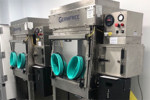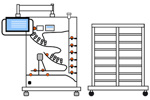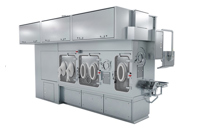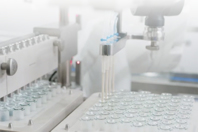INSIGHTS ON LIQUID DOSE MANUFACTURING
-
What Is A Bowie-Dick Test And Its Importance For Sterility Assurance?
Bowie-Dick testing ensures steam sterilizers remove air and achieve full steam penetration. Discover why this simple check is vital for compliance, safety, and preventing costly sterilization failures.
-
CAR-T And Laminar Flow Glovebox Isolators
A request was made for a containment system that would protect operators during lentivirus transfer, as well as provide a controlled environment for IL-2 charging of media, bead addition, and blood bag spiking.
-
Risk Control | Bulk Filling Application
Learn about a bulk filling system that enables you to achieve risk control, accuracy, and superior product recovery in your fill and finish operations.
-
Explore A High-Performing Basal Medium And Feed Pairing
A customer sought to replace a chemically defined CHO medium with a more efficient medium and feed pairing strategy in bioreactors.
-
Importance Of Assessing Mannitol Crystallinity In Lyophilized Drug Products10/16/2024
Drug product stability may be seriously compromised if mannitol completes crystallization during storage rather than during the freezing or annealing step in the lyophilization process.
-
Importance Of Modularity In Drug Manufacturing Aseptic Filling Systems6/17/2024
Learn about a flexible aseptic processing system that provides modular, semi-automated, and fully automated solutions to meet demands at all stages of development.
-
Innovation In Filtration3/18/2025
Filtration removes contaminants to ensure safety and is essential in various applications, from lab-scale tasks to GMP production. Explore how its simplicity and reliability make it indispensable.
-
5 Common Bowie-Dick Test Failures And How To Prevent Them11/26/2025
Bowie-Dick test failures indicate serious sterilization issues. Learn the five most common causes and proven strategies to prevent downtime, compliance risks, and compromised product integrity.
-
The Successful Implementation Of A New Aseptic Filling Line10/10/2024
Discover how a Quality by Design approach can streamline the development of new sterile product filling lines, featuring a real-life example illustrating its effectiveness.
LIQUID DOSE MANUFACTURING SOLUTIONS
-
API Process Development System designed to provide personnel and product protection while working with powder and liquid substances. Designed to house a Mettler Toledo Easy Max 102, Vacuum Oven, and IKA LR 1000.
-
Pharmaceutical companies, researchers, scientists, and medical professionals work tirelessly to create and bring crucial vaccines and immunizations to the market. Understanding key product characterization details such as sterilization, secure packaging and optimal process conditions for manufacturing are necessary elements of the vaccine development process. The right vaccine development machines and filling equipment minimize obstacles to gaining this poduct and process knowledge. To aid the vaccine development process, AST’s vaccine filling machine, GENiSYS®C allows scientists and pharmaceutical companies to differentiate their vaccine product and develop data-driven manufacturing processes in more meaningful and scalable ways.
-
If you are looking for filling systems for different products such as liquids, powder, or flow-resistant highly viscous materials, Dec provides a modular concept allowing to meet a variety of packaging that is appropriate in the field of research and development as well as clinical trials. Speed up your go-to-market strategy with innovation and modular thinking.
-
AST’s ASEPTiCell® and GENiSYS® systems combine industry-proven technologies such as robotics and isolator-barrier systems to provide flexible pharmaceutical aseptic filling and closing of ready-to-use vials, syringes, and cartridges with a single machine. These innovative platforms use a modular design approach to provide a truly adaptive system with the capabilities and features necessary for cGMP production of clinical and commercial sterile injectable products.
-
Our Bench Vision Unit has been developed to provide maximum flexibility, with the same software and component design as our automatic visual inspection equipment used on production lines throughout the world.
- Container range: ampoules, vials, cartridges, syringes
- Inspected products: water-like, viscous, suspensions














